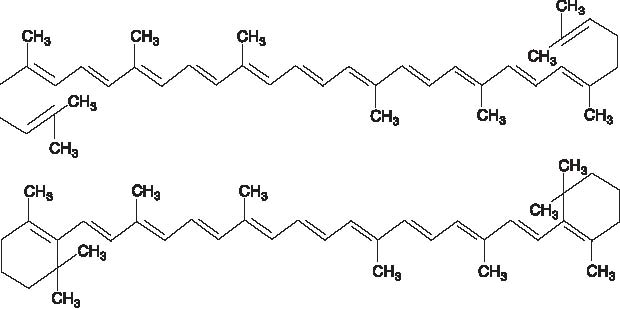 |

|
 |

|
 Back to 2000 2nd Quarter Table of Contents
Back to 2000 2nd Quarter Table of Contents
Introduction To date, about 600 different carotenoids have been discovered. Carotenoids are fat-soluble nutrients that help give orange, red and yellow color to various plants and, in some cases, are associated with chlorophyll.1 Since these compounds were first isolated from carrots, they are called carotenoids. There are about 20 different carotenoids present in human plasma. The five most abundant in human plasma are lutein, lycopene, beta-cryp-toxanthin, alpha- and beta-carotene.2 The best known member of the carotenoids is beta-carotene. It is an antioxidant that helps stimulate the immune system and protects against some types of cancer. In addition to acting as an antioxidant on its own, beta-carotene has the ability to produce two molecules of vitamin A. Other carotenoids lack this ability. Alpha-carotene, for example, is only half as efficient in producing vitamin A as beta-carotene, while lycopene lacks the ability to form any vitamin A.3 Lycopene has a strong antioxidant effect and has been shown to be effective in neutralizing singlet oxygen, a very potent free-radical. Additional studies have shown that lycopene has a higher tissue concentration than the other carotenoids.4 The highest level has been found in the testes, followed by the adrenal, liver, serum, ovary, fat and kidneys.5 Another study confirmed the high tissue level of lycopene in the lung, colon, breast and skin as compared to alpha-carotene, beta-carotene, cryptoxanthin and lutein.6 The high tissue levels may help explain the recent findings that lycopene is protective against certain cancers, especially prostate cancer. A six-year study of 800 men compared the incidence of prostate cancer to their intake of five different carotenoids. Of the five, lycopene was the only one shown to have a significant preventive effect. Another important finding dealing with diet and prostate cancer is that men from Mediterranean countries eating a diet high in tomatoes or tomato sauce have lower rates of prostate cancer than men in other countries. Two or more servings of tomato products a week resulted in a 35% reduction in prostate cancer risk. The serum lycopene level in people from Italy is about six times higher than those from Ireland and about three times higher than those from England. Tomato sauce was more effective than tomato juice or tomato fruits in providing protection against prostate cancer.7 Lycopene has also been shown to be effective in in preventing cervical intraepithelial neoplasia and as an inhibitor to cancer cells of the breast, endometrium and lung.8 Foods high in lycopene are tomato catsup, tomato paste, and the raw tomato fruit, guava, watermelon, grapefruit and papaya. Lycopene supplements are available from several commercial companies as an extract from tomatoes. Lycopene is best absorbed when taken with oil.9 The chemical structure of lycopene compared to beta-carotene is shown in Figure 1 (p.104). The molecular weight (536.85) and formula (C40H56) is the same for both compounds. The main difference is that the two end rings in lycopene are open, while those of beta-carotene are closed. At The Center, we have developed a procedure for measuring vitamin A, vitamin E, beta-carotene and lycopene on a single sample using high performance liquid chromatography (HPLC). This is a very accurate and fast way of determining plasma levels of these fat-soluble substances in a patient. Center physicians prescribe nutrients based upon actual plasma, serum, tissue (red blood cell, whole blood, hair) or urine levels of these nutrients. Reference values established for our patient population (194 adult males and females) on the four nutrients described above are: Figure 1. Comparison of Lycopene and Beta Carotene  vitamin A 30 to 110 μg/dL beta-carotene 5 to 65 μg/dL lycopene 10 to 50 μg/dL vitamin E 0.6 to 2.7 mg/dL We are very interested in using serum lycopene results in evaluating a patient’s risk for developing certain types of cancer, especially prostate cancer. It will also be interesting to compare serum lycopene levels to serum prostate specific antigen (PSA) levels in normal men and those diagnosed with prostate cancer. To our knowledge, this has not been done. Very preliminary data comparing two men with prostate cancer to two men without prostate cancer are shown in Table 1 (below). As seen from the limited data, there seems to be a strong correlation between the serum PSA land lycopene levels. This PSA versus lycopene comparison will be the subject of a future article as additional data are gathered. We would also welcome data from other laboratories as the availability of lycopene testing becomes more prevalent. References
Table 1. Lycopene Levels in a Patients with and without Prostate Cancer Serum Lycopene PSA(normal 10 to 50 ug/dL) (normal 0 to 4 ng/mL) Patient 1 18 μg/dL 52.3 ng/mL- prostate cancer Patient 2 20 μg/dL 32.8 ng/mL- prostate cancer Patient 3 40 μg/dL 0.8 ng/mL- normal Patient 4 34 μg/dL 1.8 ng/dL - normal |

This website is managed by Riordan Clinic
A Non-profit 501(c)(3) Medical, Research and Educational Organization
3100 North Hillside Avenue, Wichita, KS 67219 USA
Phone: 316-682-3100; Fax: 316-682-5054
© (Riordan Clinic) 2004 - 2024c
Information on Orthomolecular.org is provided for educational purposes only. It is not intended as medical advice.
Consult your orthomolecular health care professional for individual guidance on specific health problems.